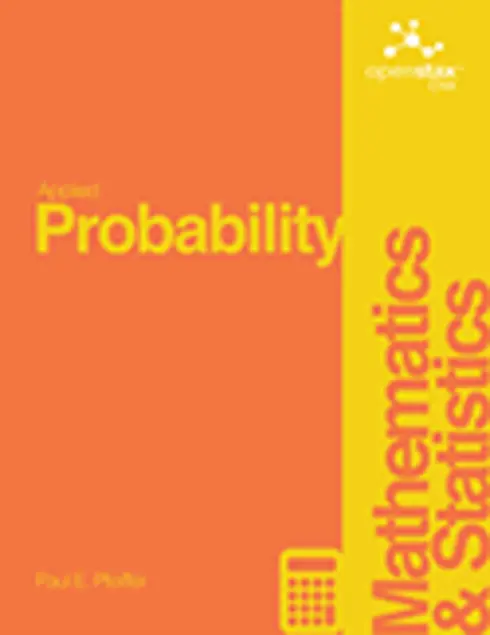
Applied Probability
No ratings
Paul Pfeiffer, Rice University
Copyright Year:
Publisher: OpenStax CNX
Language: English
Formats Available
Conditions of Use
![]() Attribution
Attribution
CC BY
Table of Contents
- 1 Preface
- 2 Probability Systems
- 3 Minterm Analysis
- 4 Conditional Probability
- 5 Independence of Events
- 6 Conditional Independence
- 7 Random Variables and Probabilities
- 8 Distribution and Density Functions
- 9 Random Vectors and joint Distributions
- 10 Independent Classes of Random Variables
- 11 Functions of Random Variables
- 12 Mathematical Expectation
- 13 Variance, Covariance, Linear Regression
- 14 Transform Methods
- 15 Conditional Expectation, Regression
- 16 Random Selection
- 17 Conditional Independence, Given a Random Vector
- 18 Appendices
About the Book
This is a "first course" in the sense that it presumes no previous course in probability. The mathematical prerequisites are ordinary calculus and the elements of matrix algebra. A few standard series and integrals are used, and double integrals are evaluated as iterated integrals. The reader who can evaluate simple integrals can learn quickly from the examples how to deal with the iterated integrals used in the theory of expectation and conditional expectation. Appendix B provides a convenient compendium of mathematical facts used frequently in this work. And the symbolic toolbox, implementing MAPLE, may be used to evaluate integrals, if desired.
In addition to an introduction to the essential features of basic probability in terms of a precise mathematical model, the work describes and employs user defined MATLAB procedures and functions (which we refer to as m-programs, or simply programs) to solve many important problems in basic probability. This should make the work useful as a stand-alone exposition as well as a supplement to any of several current textbooks.
Most of the programs developed here were written in earlier versions of MATLAB, but have been revised slightly to make them quite compatible with MATLAB 7. In a few cases, alternate implementations are available in the Statistics Toolbox, but are implemented here directly from the basic MATLAB program, so that students need only that program (and the symbolic mathematics toolbox, if they desire its aid in evaluating integrals).
Since machine methods require precise formulation of problems in appropriate mathematical form, it is necessary to provide some supplementary analytical material, principally the so-called minterm analysis. This material is not only important for computational purposes, but is also useful in displaying some of the structure of the relationships among events.
About the Contributors
Author
Paul E. Pfeiffer, Professor Emeritus of Computational and Applied Mathematics, received his BS and MS in Electrical Engineering at Rice in 1938 and 1948, respectively, and his Ph.D. in Mathematics from Rice in 1952. In between, Paul earned a Bachelor of Divinity from the Perkins School of Theology at SMU in 1943. Paul was on the Rice faculty from 1947 until 1998, first as an instructor and, after receiving his PhD, as an assistant, then an associate, and since 1959, as a full professor. His positions at Rice included: Chairman of the Department of Electrical Engineering 1960-1963, Chairman of the Department of Mathematical Sciences 1974-1975, interim master of both Wiess College and Brown College, and Dean of Students 1965-1969.
